Dear Reader, in this age of AI created content, please support with your goodwill someone who works harder to provide the human-made. Sign up at the top of the lefthand column or bottom of this page. You will receive my hand illustrated monthly newsletter RESTORE NATURE and access to the biodiversity garden design course as I write...and nothing else, I respect your time. I am also removing the advertizing as best I can as its become intrusive inappropriate and pays me nothing.
Water-wise gardening practice
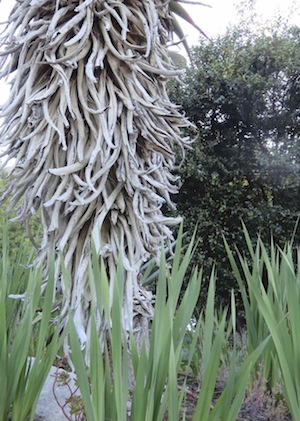
Introduction to water-wise gardening practice
and preparation for designing
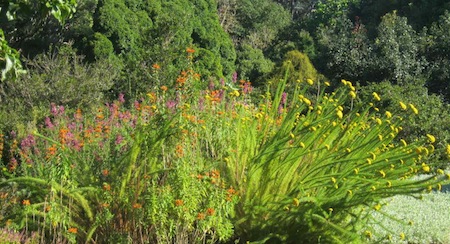 Kirstenbosch showing the way for water-wise gardening with a burst of warm colour
Kirstenbosch showing the way for water-wise gardening with a burst of warm colourThis is the first series of articles on water-wise gardening practice. See links at the bottom of the page for the next article. They are based on Heidi Gildemeister’s wonderful book Mediterranean Gardening: A Waterwise Approach (1995), which I've supplemented with input from Ernst Van Jaarsveld’s book on Waterwise Gardening in South Africa and Namibia (2010), and some information on other winter rainfall regions where needed. We deal now with actual gardening behaviour and practices. The individual plants appropriate to your region will need further research, as there is so much diversity in climate, microclimate, the regional flora, and the individual plant’s growing needs, that one cannot generalize with planting recommendations for all regions of the world.
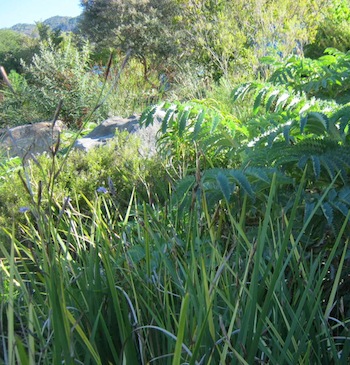 Learn to love the look of indigenous planting
Learn to love the look of indigenous plantingThe place of native plants in water-wise gardening
Ernst van Jaarsveld (2010) defines water-wise gardening as using indigenous planting, and I think native plants are essential to decorative water-wise gardening and should be the default planting in all the water stressed regions of the world. I’m planning more articles on plant choices for the water-wise garden that work with native plants exclusively, as well as plant choices that are less purist, especially regarding food gardening. We can’t all afford gardens let alone purely decorative ones.
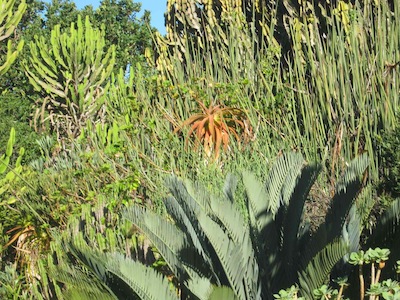 robust succulent thicket in water-wise planting
robust succulent thicket in water-wise plantingWhy water-wise gardening is necessary
The necessity of water-wise gardening as seen in 2010 (van Jaarsveld) was to maintain the green lung of the earth and fight global climate change this way. Since then the intelligent use of resources he speaks of has become more critical in South Africa with the drought. It is an ugly picture indeed with water access for the overwatered gardens and swimming pools of the privileged being fiercely defended in social media while others lack drinking water and food security. We stand at the brink of a terrible crisis. It has become a prosocial act to have a garden that does not need drinking water, and produces food, and to learn how to do this.
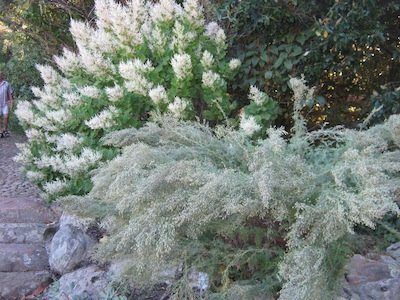 indigenous planting in shades of grey and white
indigenous planting in shades of grey and whiteGildemeister's water-wise gardening steps
Gildemeister structures her water-wise gardening information into an eight step program. I have used a lot of these points and there is comprehensive overlap with van Jaarsveld's advice for South African and Namibian gardeners. I have reorganized it all to accommodate other information and isolate the actual plant information like botanical names and concrete planting suggestions into a separate set of articles dealing with plant lists. Before that I will just mention her eight steps, in case they are useful to you.
plan well
provide shade and plant cover
reduce the lawn and use alternatives
use driought tolerant plants
group plants for water needs
plant water management
use water saving practices
design the garden for all seasons
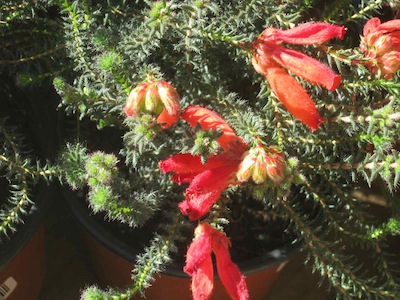 To be water-wise you have to deal with some uncooperative and prickly customers
To be water-wise you have to deal with some uncooperative and prickly customersBefore designing a water-wise garden, observe your site and research your plants
I think that producing a really water-wise garden, an intelligent garden, in a zone with dry summers and wet winters needs more careful planning than one in a region with year round rain, or year round drought. We have many of the problems experienced in climates with extreme temperature fluctuations, but we have rainfall fluctuations. Gildemeister urges that careful observation and plant research is important in Meditarranean climates before progressing into garden building.
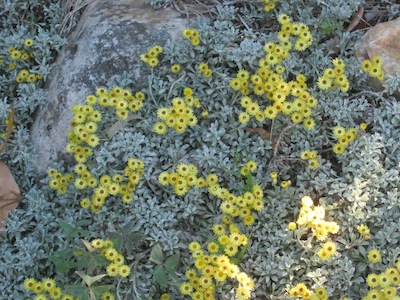 know your site, choose plants which fit: a thin dry skin of soil around some boulders is enough for this lovely Helichrysum
know your site, choose plants which fit: a thin dry skin of soil around some boulders is enough for this lovely HelichrysumGetting to know your site is part of water-wise gardening
Gildemeister suggests waiting a year to get acquainted with your site, and observe the environment around it and the seasonal fluctuations and their effects on microclimates in the garden. For example observe where frost forms and how the cold air flows. Probe the depth of your soil in various locations. Take samples from all around the site and test the chemical properties of these samples. I couldn’t afford to do this and my small garden is flat and the soil is deep and uniform (sand). However I would at the very least do a cheap pH test, and a hand done ball test, from samples taken at different points. Slightly wet the soil and squeeze it to see how it clumps (clay is sticky, sand will fall apart, with transitions between), or swish soil samples in a bottle of water and let them settle out overnight to see the proportions of humus, sand, silt and clay, especially if there is a diversity of soils in your garden.
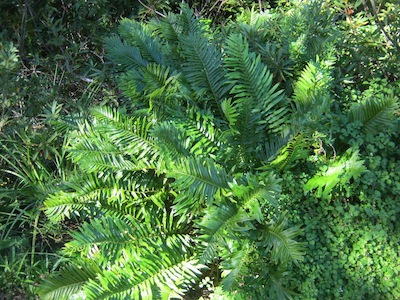 know your site, choose plants which fit: a thin skin of soil around some boulders in the wet river zone supports this lovely fern
know your site, choose plants which fit: a thin skin of soil around some boulders in the wet river zone supports this lovely fernGet to know your neighbourhood
If you can’t afford a lab, ask around the neighbourhood to find an experienced gardener who can tell you about the usual mineral deficiencies or excesses in your area. It’s a good excuse to get to know your neighbours and profit from their mistakes and successes to find out what kinds of plants and gardening projects succeed in that environment. You may also see where they have gone wrong without them even being aware of it. Just don’t tell them about it until they ask one day why your garden is doing so well ! Getting to know your neighbourhood will give you examples to follow or clues to other plants likely to do well. Plants that thrive on roadsides and in neglected areas will also thrive without water and attention in your garden. Look for species which indicate local conditions. On the Riviera hibiscus and bougainvillea thrive in the warmest parts, cedar and oak in the areas which experience frost. Find out what the average yearly rainfall is in your area, from the weather bureau, online, or by conversation with locals. The rainfall in different parts of Cape Town is so different it profoundly affects plant selection.
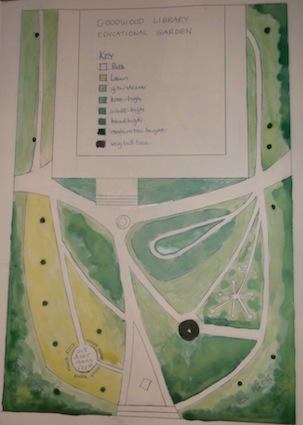 A sketch for the Goodwood Library Garden showing existing features and planned ones
A sketch for the Goodwood Library Garden showing existing features and planned onesSketching and scribbling is part of water-wise gardening
Draw maps, and remember fitting and creative solutions take time. It is a complex task to coordinate the demands of all the plants and the layout they will fit into. Let it brew in your mind, but stay on the job adding to it regularly, and keep a visual record of your imaginings
Plan against erosion and wind damage
If your plot is on a slope, create horizontal lines. These could be terraces, paths, berms (soil dams) or material such as logs. Keep paths horizontal as far as possible, use steps in changes of level as they also are horizontal and conserve water. Edge paths and terraces with ground covers and plants with good soil conserving roots. If you are short on soil, fill terraces with building rubble and top off with soil and let what plants comes up come up. Plant tall wind resistant plants as wind breaks on the windward side of your garden if needed.
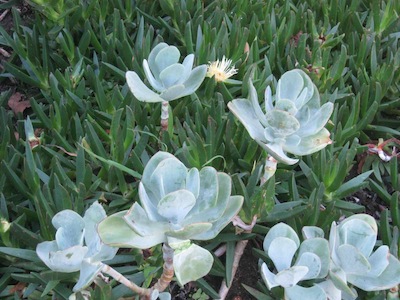 in the dry, these different greens will delight the eye
in the dry, these different greens will delight the eyePlan for dealing with water scarcity as well as excess
Make sure when the water comes in floods of rain, or even drains from areas up slope from your site, that it is not destructive. First observe during a downpour where problems arise and then correct them. Soil water retention is improved by groundcover and mulch. Surface drains, gravel filled ditches and terracing all help recharge ground water. Collect water in the rainy season in whatever type of container you can afford. We use wheelie bins and cubic meter liquid containers left over from the shipping industry, and save drinking water in 100 litre drums. These are all not really large enough to bridge the dry season. Those who can afford it need to construct cisterns of several thousand litres. at least if you can afford it. These can be placed under paved areas like drive ways, or within terraces, or they can be open as water features or pools. When you know where most of the water flows, construct mini dams in its path to reduce its strength, slow the passage of water off your property and recharge the ground water, and prevent erosion. You can place bunches of sticks or faggots across the stream. Some can be water loving species which will root in watercourses. Lay branches or logs over surfaces susceptible to erosion. Using gray water is problematic in Fynbos gardens as native plants are used to phosphate deficient soils. In my experience the Pelargoniums took a nosedive on gray water, but the exotic vegetables like mustard, cabbage, tomatoes and chilis love this sulphurous brew.
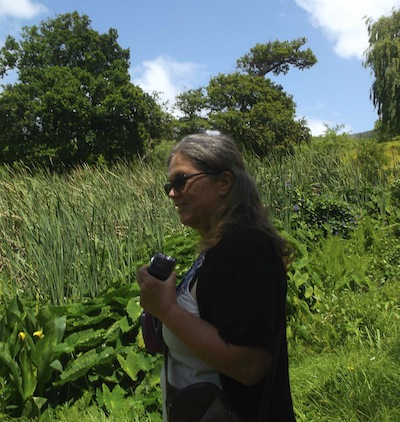 in the wet, this thick river vegetation will slow the flow
in the wet, this thick river vegetation will slow the flowWhats up next in the water-wise gardening series
The next topic will be general considerations when planning your planting.
------
home page for links on natural gardening craft
------
useful informational links on natural garden design
------
thinking about drought tolerant plant adaptions
------
album of lawn replacements and ground covers
------
albums on Mediterranean water-wise gardening
Restore Nature Newsletter
I've been writing for four years now and I would love to hear from you
Please let me know if you have any questions, comments or stories to share on gardening, permaculture, regenerative agriculture, food forests, natural gardening, do nothing gardening, observations about pests and diseases, foraging, dealing with and using weeds constructively, composting and going offgrid.
You’re a home gardener ! Share your experiences and questions !
We all know about home gardening. Tell us about your successes, challenges and ask about issues that bother you. You may have the luxury of a back garden, but there are other ways we learn. Few people age without growing something or buying vegetables during their lives ! It is absolutely guaranteed that you have learned things which can help others on their gardening journey.
We invite you to share your stories, ask questions, because if a thing has bothered you it will bother others too. Someone may have a solution ! No question is too small. There is learning for everyone involved, for you, for me (yes, I learn from every question), for us all. Exciting stuff !
We are starting on a new journey. Every week we will profile your letters ! The best stories and questions we receive.
SEARCH
Order the Kindle E-book for the SPECIAL PRICE of only
Prices valid till 30.09.2023
Recent Articles
-
garden for life is a blog about saving the earth one garden at a time
Apr 18, 25 01:18 PM
The garden for life blog has short articles on gardening for biodiversity with native plants and regenerating soil for climate amelioration and nutritious food -
Cape Flats Sand Fynbos, Cape Town's most endangered native vegetation!
Apr 18, 25 10:36 AM
Cape Flats Sand Fynbos, a vegetation type found in the super diverse Cape Fynbos region is threatened by Cape Town's urban development and invasive alien plants -
Geography Research Task
Jan 31, 25 11:37 PM
To whom it may concern My name is Tanyaradzwa Madziwa and I am a matric student at Springfield Convent School. As part of our geography syllabus for this
"How to start a profitable worm business on a shoestring budget
Order a printed copy from "Amazon" at the SPECIAL PRICE of only
or a digital version from the "Kindle" store at the SPECIAL PRICE of only
Prices valid till 30.09.2023







